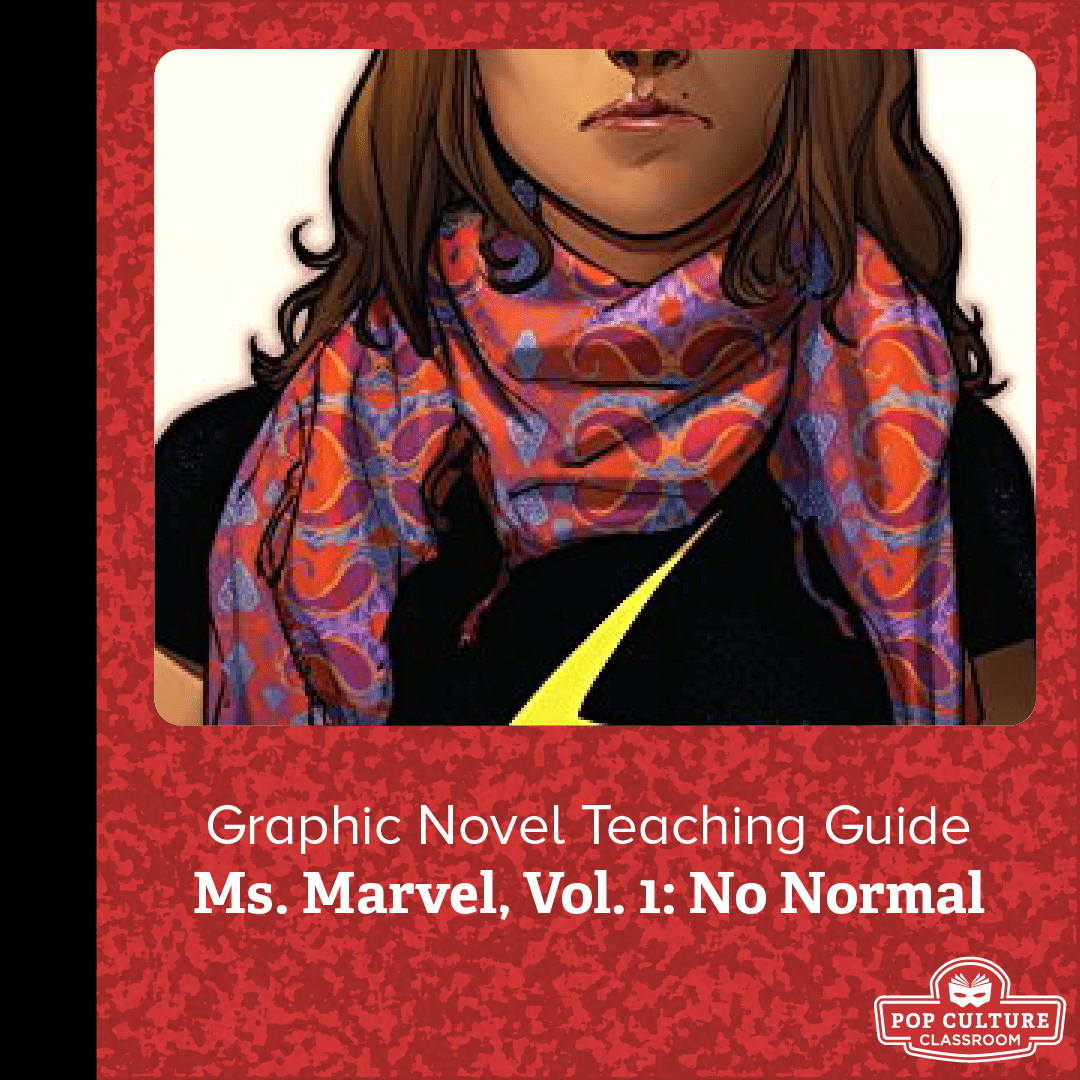Classroom Teaching Guide
Ms. Marvel, Vol. 1: No Normal is the story of Kamala Khan, a Muslim teenager from Jersey City, who rebels against her parents’ wishes, to attend a party. As she struggles at the party to fit in with her classmates, a mysterious mist endows Kamala with amazing powers. This, of course, changes her life substantially, as she has to decide whether to conceal her powers from her family and friends, and whether to use them to fight crime.
Hi! Before you read this review, you may want to read “How to Teach with Comics”, for a basic foundation on why comic books and graphic novels are an effective teaching tool.
ISBN 078519021X (ISBN13: 9780785190219), English
Difficulty
5-12 grade level.
This book explores high school situations, specifically the social development of teenagers. There are scenes of violence and brief discussions of teen dating, as well as explorations of conflicting cultures. The vocabulary is consistent with the reading level of most young adult fiction, and the author strikes a good balance between drama and comedy. In addition, the artist packs the background with funny sight gags.
Themes
Friendship – Kamala has a core of friends who she’s able to discuss her struggles with, whether internal or external.
- Culture and religion- As an American raised by immigrant parents, Kamala struggles with the clash of her parents’ culture and the culture she was raised in. This shows itself in both comical and serious ways in the story.
- Acceptance – Kamala searches for acceptance from her family and her peers, and tries to find peace with her own identity, even as she struggles to define it.
Discussion Questions
- The author uses Kamala’s family to illustrate the cultural differences between growing up in America and growing up in Pakistan. How does this difference come through in their conversations?
- How does the author use Kamala’s friendships to show her strengths and weaknesses? Cite examples from the story.
- The author spends a significant amount of time contrasting Kamala’s physical appearance with that of her favorite superhero, Carol Danvers/Captain Marvel. Why do you think Wilson made this storytelling decision? What do these physical differences say about Kamala’s acceptance of her own heritage?
- Kamala’s family seems to be more protective of her than they are of her brother. What similar ways do you see boys and girls treated differently in your own culture? Where do you think these differences come from?
- Kamala tries to keep her powers a secret from everyone at first. Do you think this was the right decision? How do you decide what to share with family and friends, or what to keep to yourself?
- One of Kamala’s struggles was deciding how much of her culture to share with the people in her school. How should she have handled that? How would you?
- Explore with students how this text may remind them of another story, book, movie or song. They can identify similarities and differences in these familiar media, and then discuss how those themes show up in their own lives, as well as current world events. When students can build these connections, they are able to better comprehend and make meaning of the ideas in the text.
Lesson Ideas
- This book is most suited for upper middle and high school grade levels.
- Based on grade level and reading ability, students can read the story independently or with partners. If you choose to read it as a whole class, you may consider projecting the pages onto a screen and assigning different students to read various characters’ dialogue.
- If some students are unfamiliar with the format, you may want to use the article linked at the top of this page as a quick lesson in how to read graphic novels. You’ll want to go over this quick lesson as a class, to make sure everyone understands it before proceeding with the reading in this lesson.
Reading/writing
- Be sure to review the definitions of vocabulary terms. You’ll want to pull words out of the story that are appropriate to the grade level you’re teaching.
- Lead students in a discussion of storytelling devices employed in this book, like humor, foreshadowing, conflict, etc.
Art
- Lead students in a discussion of how the story’s art communicates its themes (through color, page design, lettering, panel placements, style).
Social studies
- Lead students in a discussion in which you have them identify the themes of the graphic novel, and how they touch on political and social themes of today.
- Lead students in a discussion about the social and political conflicts of coming from another country, and trying to assimilate into American life.


